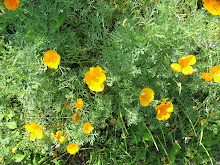 However, my raspberries and broccoli haven't received the memo. The rainy fall conditions have prolonged the growing season for both, with new berries for the former and the continued production of sideshoots for the latter. Otherwise, most everything else is ready to go. I had forgotten (or have been too embarrassed) to take a photo of my bean supports that fell over weeks ago. The tomatoes and peas are gone, and the perennials have been deadheaded but ready to be trimmed back completely. In about another week, material to be composted offsite will probably overflow on this tarp.
However, my raspberries and broccoli haven't received the memo. The rainy fall conditions have prolonged the growing season for both, with new berries for the former and the continued production of sideshoots for the latter. Otherwise, most everything else is ready to go. I had forgotten (or have been too embarrassed) to take a photo of my bean supports that fell over weeks ago. The tomatoes and peas are gone, and the perennials have been deadheaded but ready to be trimmed back completely. In about another week, material to be composted offsite will probably overflow on this tarp. One of my post ideas for earlier this summer was to showcase the elaborate supports built by my fellow gardeners. Some have been taken down already while others have the skeletal remains of whatever they supported clinging to them. Grotesquely bulging and overripe beans. Blighted tomato stems rotting against metal rings. If not slimy to the touch then crinkling from dryness. It's a shame I never got around to executing this idea, but there's always next season.
One of my post ideas for earlier this summer was to showcase the elaborate supports built by my fellow gardeners. Some have been taken down already while others have the skeletal remains of whatever they supported clinging to them. Grotesquely bulging and overripe beans. Blighted tomato stems rotting against metal rings. If not slimy to the touch then crinkling from dryness. It's a shame I never got around to executing this idea, but there's always next season.Here are a few photos of what's still up. A lean-to that the creator had intended for cucumbers (notice the nice brussel sprouts next to it).
 One substantial setup that once had peas climbing up strings, and still supporting the highest cosmos I've ever seen.
One substantial setup that once had peas climbing up strings, and still supporting the highest cosmos I've ever seen. One of several pea trellises made from pipes, broomsticks, and chicken wire.
One of several pea trellises made from pipes, broomsticks, and chicken wire. And one of my favorites: the arch connecting two raised beds designed for the handicapped. As in previous years, that will stay up throughout the winter, poking out from the snowbanks.
And one of my favorites: the arch connecting two raised beds designed for the handicapped. As in previous years, that will stay up throughout the winter, poking out from the snowbanks.

























